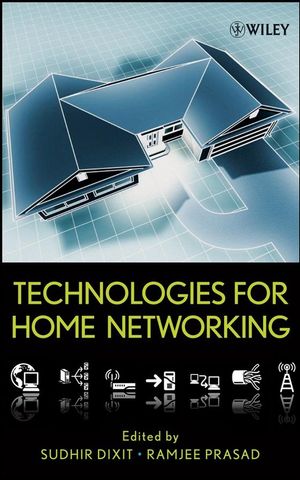Technologies for Home NetworkingISBN: 978-0-470-07374-2
Hardcover
240 pages
February 2008
 |
||||||
Contributor List.
1 Introduction to Networked Home.
Mahbubul Alam, Sudhir Dixit, and Ramjee Prasad
1.1 Background.
1.2 Technology Adoption Trends.
1.3 Social Network.
1.3.1 Business Applications.
1.4 Consumer Trends.
1.5 Living in Real Time.
1.6 Confluence of Events.
1.7 Application and Service Convergence.
1.8 Network Convergence and Regulations.
1.9 Terminal Convergence.
1.10 Home Networking.
1.10.1 Home Computing.
1.10.2 Home Entertainment.
1.10.3 Home Communications.
1.10.4 Home Monitoring and Management.
1.11 Connected Home.
1.12 Vision of the Future.
1.13 Brief Overview of the Book.
1.14 Conclusions.
References.
2 Media Format Interoperability.
Anthony Vetro
2.1 Background.
2.2 Media Formats.
2.2.1 Image and Video Formats.
2.2.2 Audio Formats.
2.2.3 Transport and File Formats.
2.2.4 Profiles and Levels.
2.3 Metadata Formats.
2.3.1 Content Descriptions.
2.3.1.1 Media Format.
2.3.1.2 Data Abstraction.
2.3.1.3 Multiple Variations.
2.3.1.4 Transcoding Hints.
2.3.2 Usage Environment Descriptions.
2.3.2.1 Terminal Capabilities.
2.3.2.2 Network Characteristics.
2.3.3 User Preferences.
2.3.4 Electronic Program Guide.
2.4 Media Adaptation.
2.5 Mandatory Media Format Profiles.
2.6 Media Format Interoperability: An Example.
2.7 Conclusions.
References.
3 Media Description and Distribution in Content Home
Networks.
Edwin A. Heredia
3.1 Diversification of Media Format Variants.
3.2 Content Home Network Architecture Components.
3.3 Content Format Variants in the Home.
3.4 Description of Content Features and Device Capabilities.
3.5 Media Exchange Description Language.
3.5.1 MXDL Media Object Descriptions.
3.5.2 MXDL Device Capability Descriptions.
3.6 Conclusions.
References.
4 Mobile Device Connectivity in Home Networks.
Mika Saaranen and Dimitris Kalofonos
4.1 Related Work.
4.2 Basic Home Use Cases.
4.3 Home Networking Challenges.
4.4 Architecture and Technologies for Local and Remote
Home Connectivity.
4.4.1 Overview of Home Connectivity
Architecture.
4.4.2 Local Connectivity.
4.4.3 Remote Connectivity.
4.5 Conclusions.
References.
5 Generic Access Network Toward Fixed - Mobile
Convergence.
Claus Lindholt Hansen
5.1 Trends in the Industry.
5.2 Standardization.
5.3 Gan Overview.
5.3.1 Security.
5.3.2 "Discovery" and "Registration".
5.3.3 Rove in and Rove Out.
5.3.4 Transparent Access to Services in the
Mobile Core Network.
5.3.5 GPRS Support in GAN.
5.3.6 Location Services.
5.3.7 Emergency Services.
5.3.8 GAN Protocol Architecture.
5.3.9 Bluetooth or Wi-Fi?
5.4 Benefits with the GAN Technology.
5.4.1 Operators.
5.4.2 End User.
5.4.3 Terminal Availability.
5.5 Practical Experiences.
5.6 Impact on Networks and Processes.
5.7 Discussion.
5.8 Evolution of GAN.
5.9 Conclusions.
6 Secure Wireless Personal Networks: Home Extended to Anywhere.
John Farserotu and Juha Saarnio
6.1 AVision of a Personal Network.
6.2 Some Example Scenarios.
6.2.1 Health.
6.2.2 Home and Daily Life.
6.2.3 Distributed Work.
6.3 System and Requirements.
6.4 User Requirements and Scenarios.
6.5 Network Architecture.
6.6 Access and Access Control Techniques.
6.7 Security.
6.8 Devices and Service Platforms.
6.9 System Optimization and Operator Perspectives.
6.10 Toward Personal Services over Personal Networks.
6.11 Conclusions.
References.
7 Usable Security in Smart Homes.
Saad Shakhshir and Dimitris Kalofonos
7.1 Survey of Related Work.
7.1.1 User Interaction with Security.
7.1.2 Security in Smart Spaces.
7.1.3 User Interaction with Security
in Smart Spaces.
7.2 Basic Home Security Use Cases.
7.3 A Smart Home Security Model.
7.4 Design Challenges.
7.5 Usability.
7.6 Conclusions.
References.
8 Multimedia Content Protection Techniques in
Consumer Networks.
Heather Yu
8.1 Techniques for Multimedia Content Protection.
8.1.1 Basic Security Requirements for
Content Protection.
8.1.1.1 Application Requirements.
8.1.1.2 Technology Requirements.
8.1.2 Traditional Techniques.
8.1.2.1 Encryption and Authentication.
8.1.2.2 Key Management.
8.1.2.3 Challenges for Multimedia Applications.
8.1.3 Advanced Cryptography Algorithms for Multimedia Content
Protection.
8.1.4 Digital Watermarking.
8.2 Techniques for Content Protection in Consumer
Networking Environment.
8.2.1 Existing Consumer Entertainment Content
Protection Technologies: A Quick Overview.
8.2.2 The Consumer Network "Boundary Problem".
8.2.3 Case Study: Protecting Streaming Media in Heterogeneous
Network Environment.
8.2.3.1 An Application Scenario.
8.2.3.2 Scalable Plaintext Media Streaming.
8.2.3.3 Scalable Secure Media Streaming.
8.2.4 Alternative Approach for Preserving Content Copyright Without
Sacrificing Consumer Convenience and Freedom of Use.
8.3 Providing User-centric Services for Content Protection in
Consumer Networks.
References.
9 Device and Service Discovery in Home Networks.
Paul Wisner, Franklin Reynolds, Linda Ka¨llstro¨m,
Sanna Suoranta, Tommi Mikkonen, and Jussi Saarinen
9.1 Device and Service Discovery.
9.1.1 Common Attributes.
9.1.2 Interoperability.
9.1.3 Distributed Middleware Toolkits.
9.1.4 Other Discovery Protocols.
9.1.5 Directory Services and Other Configuration
Management Systems.
9.2 The Home and the Extended Home.
9.2.1 Characteristics of the Home Environment.
9.2.2 Characteristics of the Extended Home Environment.
9.3 User Control Devices.
9.4 Selected Discovery Protocols.
9.4.1 SLP.
9.4.2 Bonjour.
9.4.3 Universal Plug and Play/SSDP.
9.4.4 Jini.
9.4.5 JXTA and JXTA Search.
9.4.6 DHCP.
9.4.7 Bluetooth SDP.
9.4.8 Web Services Dynamic Discovery.
9.4.9 eXtensible Service Discovery Framework.
9.5 Improving Service Discovery.
9.5.1 Security.
9.5.2 Semantics and Automatic Composition.
9.5.3 Interoperability.
9.5.4 Touch.
9.5.5 Directories.
9.5.6 Location Awareness.
9.5.7 Service Browsing.
9.5.8 Proxies.
9.6 Conclusions.
References.
10 Small, Cheap Devices for Wireless Sensor Networks.
Zach Shelby, John Farserotu, and John F.M. Gerrits
10.1 Impulse Radio UWB.
10.2 IEEE 802.15.4A.
10.3 Frequency Modulation UWB.
10.4 System-On-a-Chip.
10.5 Embedded Operating System.
10.6 Conclusions.
References.
11 "Spotting": A Novel Application of Wireless Sensor
Networks in the Home.
Henry Tirri
11.1 Heterogeneous Wireless Sensor Network Architecture.
11.2 "Spotting".
11.2.1 Tagging Physical Objects: "Spots".
11.2.2 Spot Operations.
11.2.2.1 Spot Saving.
11.2.2.2 Spot Retrieval.
11.2.3 On Key Function K.
11.2.4 Spotting with Additional Sensor Information.
11.3 Conclusions.
References.
Index.



